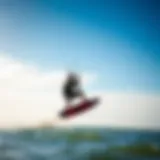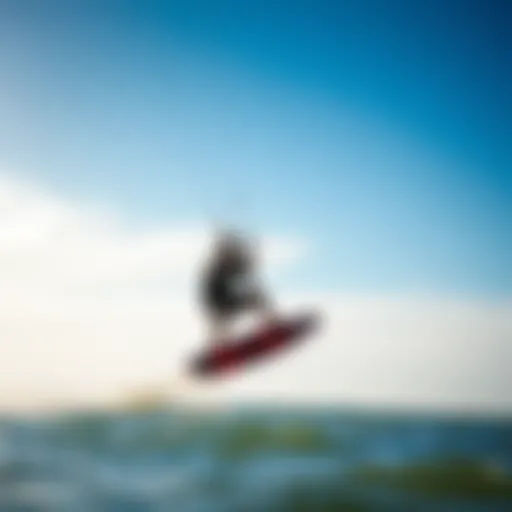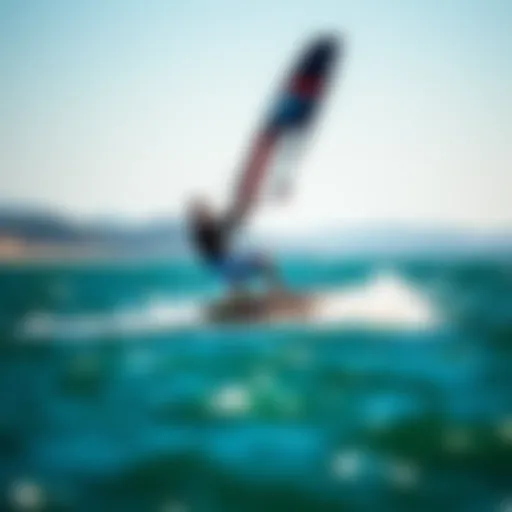Top Kitesurfing Brands: A Comprehensive Overview
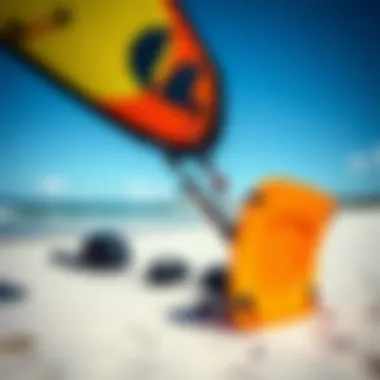
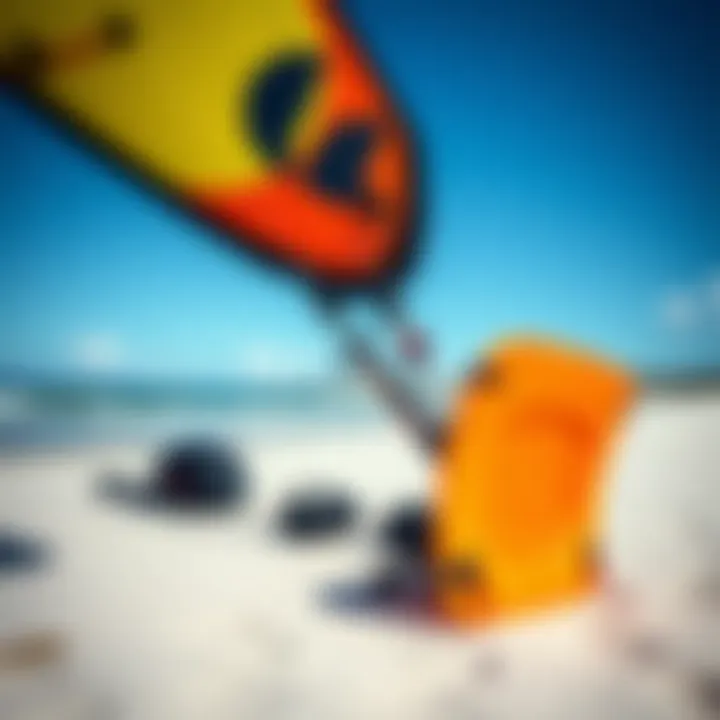
Intro
In the wide expanse of blue water, where the wind dances with waves, kitesurfing reigns as a thrilling sport. As the sport evolves, so too do the brands that serve its passionate enthusiasts. Whether you're a complete novice or a seasoned expert, understanding the credible brands behind kitesurfing plays a pivotal role in enhancing your experience. This article serves as a compass to navigate the myriad of options available, scrutinizing what makes certain brands the standouts in the kitesurfing world.
A Rich History of Kitesurfing Brands
Historically, kitesurfing prowess didn't merely spring from innovation but often from the mixing of passion and craftsmanship. Brands like Naish and Cabrinha emerged early, setting a foundation for quality and performance. These companies have consistently pushed the envelope, fostering a community and developing a rich tapestry of technology and design that defines today’s kitesurfing landscape.
Diverse offerings from various companies cater to a broad audience, providing insights not only into gear but into the very essence of the sport. By examining the cornerstone brands and their signature products, riders can understand which suits their skill level and style best.
Gear Insights
Selecting the right gear is akin to picking the right wand in a spell-binding saga; it can make or break your experience on the water. The correlation between gear quality and performance is undeniable. Top brands invest heavily in research and development, ensuring that their offerings blend comfort with cutting-edge technology.
Latest Gear Reviews
Recent innovations have left waves in the kitesurfing community. For instance, consider F-One, known for its feather-light kites that enhance maneuverability. Their Bandit series has received accolades for its versatility and responsiveness. Riders state that these kites, with their durable materials, tackle gusty winds with ease.
Similarly, Slingshot has turned heads with its Rally series, which combines stability and user-friendliness, even in challenging conditions. Equipped with features ideal for both beginners and advanced riders, this brand promotes continuous growth in skills.
"With the right equipment, every session becomes a lesson worth remembering."
Essential Gear for Beginners
For those just dipping their toes into kitesurfing, knowing what to pack can feel daunting. Start with a reliable all-round kite, suitable for varied wind conditions. Brands like Duotone provide excellent beginner options, emphasizing ease of use and stability. Alongside this, a good harness is non-negotiable. A comfortable harness allows for better control and endurance during extended sessions on the water.
Additionally, combine this with a sturdy board that balances buoyancy and maneuverability. Evolving into the sport often begins with nurturing foundational skills. Selecting gear that simplifies rather than complicates is a smart strategy for beginners.
Techniques and Tips
Once fully equipped, the next step is honing your technique. Practicing skilled maneuvers can transform your kitesurfing game, turning average outings into exhilarating adventures.
Advanced Tricks and Techniques
For the skilled rider, mastering advanced tricks is where the thrill truly lies. Jumping, spinning, and looping through the air becomes a visceral experience when executed proficiently. Keeping up with resources that discuss new techniques can help shredders stay at the cutting-edge. Engaging with platforms like Reddit or Kiteforum.com offers valuable insights from the global kitesurfing community.
Safety Practices for Kiteboarders
Safety should never be sidelined. Adhering to safety practices ensures you're prepared for the unpredictability of nature. The first line of defense is always a good understanding of the wind and water conditions. Wear a helmet and impact vest during every session; these could shield you from unexpected falls. Furthermore, carrying safety equipment like a quick-release system is paramount—it can save lives.
Engaging with nearby kitesurfing communities—be it at local beaches or through social media—helps in learning from shared experiences.
Culmination
Embarking on a kitesurfing journey is not merely about the gear you possess, but the brand that accompanies you and the expertise you cultivate. Each of these facets creates a canvas for a uniquely thrilling experience on the water. Investing time to understand the brands and their offerings will undoubtedly amplify your enjoyment and performance in this exhilarating sport.
Foreword to Kitesurfing Brands
When it comes to kitesurfing, the gear you choose can make or break your experience on the water. The world of kitesurfing brands is filled with options that can often be overwhelming for newcomers and seasoned riders alike. A solid understanding of this landscape is crucial for anyone who’s serious about the sport. It’s not merely about the thrill of flying across the waves; it’s equally about selecting the right equipment that aligns with your skills, preferences, and page of personal adventure.
The Evolution of Kitesurfing Gear
Over the years, kitesurfing gear has evolved remarkably. Initially, kitesurfing equipment was rudimentary, featuring basic kites and boards that looked more like makeshift contraptions than specialized gear. The first designs were fraught with limitations, lacking in the rigorous testing that modern products undergo. Early adopters of this exhilarating sport were often pioneers who focused on adapting other sports equipment for kitesurfing. However, with increasing interest, manufacturers began to see the market potential. This led to an explosion of innovation—designs became more intricate, materials lighter yet stronger, and safety measures far more robust.
Today, there exists a dizzying array of options, ranging from top-tier performance kites built for professionals to durable and forgiving models for beginners. Brands have embraced technology to enhance user experiences, employing materials such as ripstop nylon and advanced composites to ensure that each kite can withstand the elements while maintaining agility and speed. This evolution speaks volumes about the commitment brands have towards their products and users.
Importance of Brand Choice
Choosing the right brand in kitesurfing is not just a question of personal preference; it has tangible effects on your performance and safety. Different brands cater to different segments of kitesurfers, each with their own philosophies and target audiences. For example, there are brands renowned for their cutting-edge technology that appeals to high-performance enthusiasts, while others focus on accessibility and usability for novices.
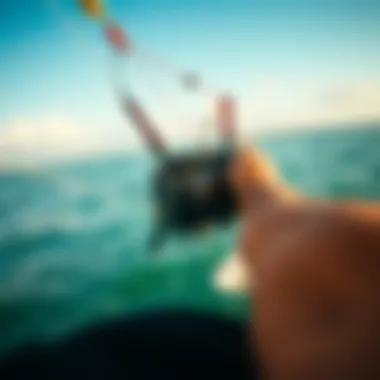

The reputation of a brand often reflects its commitment to quality and customer service. A strong brand often suggests a rigorous testing phase for their products, ensuring that customers receive gear that can handle tough conditions. Opting for a well-regarded brand may also offer the benefit of community support—many brands engage with kitesurfing communities through sponsorships, events, and user forums. A good brand can serve as a safety net, providing access to troubleshooting resources and advice.
Ultimately, the brand you choose should align with your own kitesurfing goals. Whether you're riding waves, pulling tricks, or just gliding across the surface, investing in the right brand can pave the way for memorable sessions on the water.
"The gear you ride can fundamentally alter your relationship with the ocean." – Anonymous
By taking a closer look at the leading kitesurfing brands, as well as the features they provide, you’ll be able to make informed decisions that elevate your time spent on the waves.
Key Features to Look for in Kitesurfing Gear
When shopping for kitesurfing gear, it can sometimes feel like wandering through a jungle with all the options. Selecting the right equipment isn't just a matter of brand preference or stylish looks—certain features can significantly affect your performance on the water. As any seasoned kiteboarder will tell you, knowing what to look for can provide you with an edge. Here, we'll break down essential features such as material quality, design, performance, and safety, giving you a sturdy foundation for your next gear investment.
Material Quality and Durability
One of the most critical aspects of kitesurfing gear is the material it's made from. For instance, high-quality fabrics like ripstop nylon or mylar can make a world of difference when it comes to durability and performance. A good kite should withstand the elements—whether it’s the sun's scorching rays or the relentless winds.
- Strength: Look for materials that can handle repeated use and the stress of turbulent waters. Thinner is not always better; sometimes, a heavier material may bear the load without sacrificing functionality.
- Water Resistance: Gear needs to repel water effectively. If you’ve been kitesurfing for a while, you know how quickly moisture can add up, and you don't want your kite to weigh you down.
- UV Resistance: Prolonged sun exposure can damage gear, leading to fading and degradation. Good brands will emphasize UV treatments in their materials.
By investing in high-quality materials, you're essentially investing in gear that is likely to last longer and perform better, which leads to enjoyment on the water without frequent replacements.
Design and Performance
When it comes to design, kitesurfing gear should marry aesthetics with functionality. A well-designed kite and board can boost your performance tremendously. It’s not just about looking sharp on the water; it's about how well you glide through it.
- Shape and Size: Kites come in various shapes and sizes for different wind conditions and riding styles. Understanding the nuances can help you select a kite that provides optimal lift and stability. For example, a larger kite will generate more power but can be cumbersome in strong winds.
- Board Flexibility: The right amount of flex in a board can influence how it performs. A board that’s too stiff might not absorb the choppy water well, while one that’s too flexible may feel floppy. Finding the golden mean is essential.
- Control Features: Many advanced kites offer features like depower capabilities, which allow you to control the kite's lift by adjusting its angle. This is vital in maintaining composure through gusts or sudden lulls in the wind.
A thoughtful design, therefore, leads to better maneuverability and overall performance, enhancing your experience on the water.
Safety Features
Safety in kitesurfing cannot be emphasized enough. The sport carries inherent risks, but having the right safety features can significantlly mitigate potential dangers.
- Quick Release Systems: Ensure that your kite has an intuitive quick-release system. This feature allows you to drop the kite instantly in emergencies, potentially saving you from injury or worse.
- Inflatable Structures: Many brands now utilize inflatable technologies that provide extra buoyancy. If you have a mishap, these kites can keep you afloat until help arrives or until you’re ready to relaunch.
- Visibility Enhancements: Bright colors and reflective elements can improve visibility on the water, making you more noticeable to other sailors and boats. Sometimes, a bright yellow kite is all it takes to prevent an unfortunate run-in.
By keeping an eye on these safety features, you not only protect yourself but also encourage a responsible riding culture within the community.
"Investing time in understanding your gear’s features can elevate your kitesurfing experience, bringing more joy and peace of mind as you ride the waves."
In summary, when gearing up for kitesurfing, remember to weigh material quality, design aspects, and safety features with a keen eye. Each of these elements contributes to your overall experience in the sport, making it crucial to choose wisely.
Leading Kitesurfing Brands
When delving into the world of kitesurfing, understanding which brands lead the market is crucial. This segment not only outlines notable brands but also highlights the relationship between brand choices and performance in the water. With a sport that combines skill, adrenaline, and gear, the right brand can enhance a kitesurfer's experience significantly. In this section, we’ll look closely at three leading brands that have made their mark through innovative designs and extensive customer engagement.
Brand A: Innovators in Kite Technology
Overview and History
Brand A has carved a niche with its commitment to technological advancements in kitesurfing gear. Founded in the early 2000s, the brand gained recognition for its pioneering designs that meld functionality with aesthetics. Over the years, it has made strides in material durability and performance, making it a go-to choice for both professionals and weekend warriors. The history of Brand A is a testament to its willingness to experiment, which has pushed the envelope in kite technology.
One key characteristic of Brand A's offerings is the seamless integration of user feedback into product development. They actively engage with the kitesurfing community, allowing them to adapt quickly to the changing needs of riders. This customer-centric approach not only builds loyalty but also ensures that their gear is tried and tested in real-world situations.
Flagship Products
Brand A's flagship products often include their high-performance kites and boards that are known for their impressive lift and speed. Their primary offering, the Vega Kite, boasts an innovative design that maximizes power and handling. The Vega is favored for its versatility, making it suitable for both freestyle and wave riding. Despite its strengths, some users point out that the kite's price can be a sticking point for beginners, making it less accessible for novices.
Notable Technologies
When discussing notable technologies, Brand A stands out for its use of advanced materials like ripstop nylon and PU coatings. This usage translates to better durability and resistance to wear and tear. Furthermore, the brand has pioneered a unique inflation system that reduces setup time, allowing surfers to get on the water faster. While these features contribute to a superior experience, the complexity of the technology may pose a learning curve for some users less familiar with high-end equipment.
Brand B: Performance and Reliability
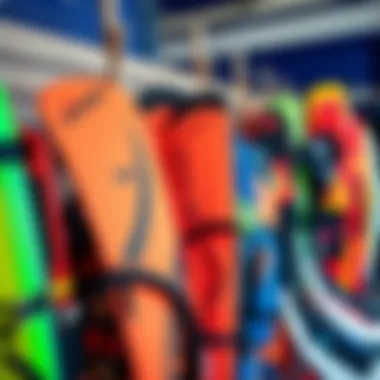
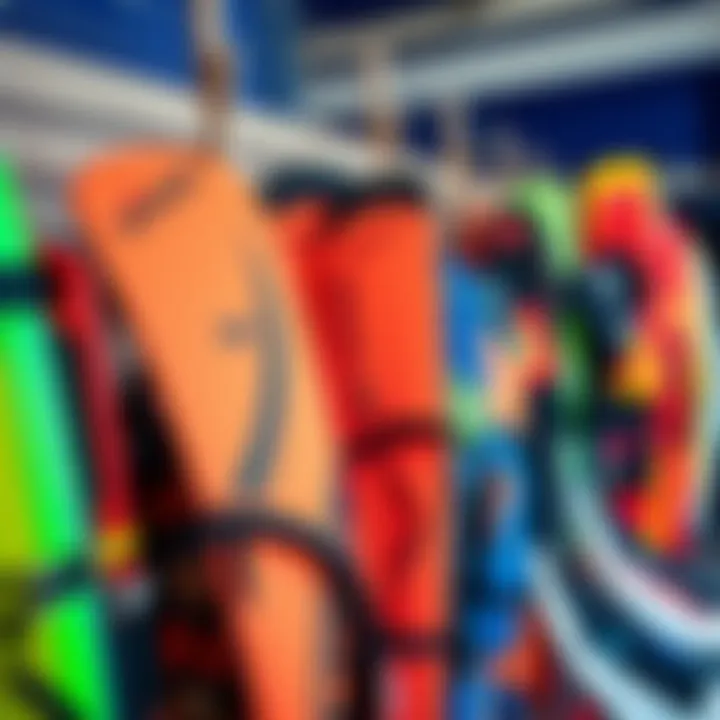
Brand Heritage
Brand B prides itself on a heritage steeped in competition and excellence. Established in the mid-1990s, it carved out a space in the market by emphasizing reliability and performance. Kitesurfers know they can rely on Brand B's products to perform under pressure, especially during competitions. Their long-term presence in the industry has nurtured a solid reputation that often translates into trust among riders.
The key characteristic of Brand B is its consistent innovation within tried-and-true designs. Riders appreciate the familiarity of the gear while benefitting from incremental improvements that enhance performance. This balance strikes a chord with those who value predictability in their equipment.
Product Range Analysis
Brand B's product range is impressively diverse, catering to everyone from novices to seasoned athletes. Their lineup includes everything from beginner kites that focus on stability to advanced models offering precise control and power. Each product line is designed with specific skill levels in mind, making it a beneficial choice for many users. However, some within the community express concern over the high prices of advanced models, suggesting that it might not be feasible for all budgets.
Customer Feedback
Customer feedback is a significant aspect of Brand B’s success. Many users laud the performance of their kites, especially for their reliability in different wind conditions. Detailed reviews often highlight the smooth ride and responsive nature of their boards as selling points. However, some feedback indicates that customer service could improve, especially regarding responsiveness to inquiries. This criticism suggests that while the products are top-notch, the experience surrounding the purchase could be enhanced.
Brand C: Catering to All Skill Levels
Target Audience
Brand C takes a unique approach by targeting a wide audience spectrum, from complete beginners to expert riders wanting the latest performance gear. This inclusivity is notable in their marketing campaigns, where they often showcase real riders of varying skill levels. Their gear is designed to encourage those new to the sport while still providing options that seasoned surfers can appreciate.
The key characteristic of Brand C’s offerings is their affordability without sacrificing quality. Their products are typically priced competitively, making them accessible for beginners who may feel intimidated by the high-end offerings of the market. However, some advanced users critique the range for lacking high-performance features, often leaning towards more established brands when pursuing elite competition.
Highlighting Entry-Level Gear
Brand C excels in creating standout entry-level gear that emphasizes ease of use and safety. Their introductory kite, the Breeze, is often praised for its stability and user-friendly design. The kite features soft edges, making it forgiving for new riders still learning to balance and steer. While it's a solid choice for beginners, the design may limit advanced maneuvers, which could deter users as they progress in skill.
Advanced Equipment Options
For those who seek performance gear, Brand C also has a range of advanced equipment tailored to experienced riders. Their Pro model boasts advanced materials and design for precision riding. Users appreciate the blend of speed and control it offers. However, the steep learning curve associated with these advanced options may pose challenges for those who recently graduated from entry-level gear, potentially leading to frustration.
In summary, the leading kitesurfing brands have established themselves through innovation, performance, and an understanding of their audience. Each brand brings a unique flavor to the market that caters to different skill levels, making the choice a vital aspect of any kitesurfer's journey.
Comparative Analysis of Kitesurfing Brands
In the competitive world of kitesurfing, brand selection plays a pivotal role in the sailing experience. A comparative analysis digs into various brands, drawing a fine line between features, pricing, and personal preferences. Such a breakdown aids enthusiasts in making informed decisions about their gear. It’s not just about picking up a kite and hopping on the board; rather, it’s about finding the right harmony between affordability, performance, and personal style.
By analyzing several brands, one can discern which ones truly stand out when it comes to critical factors like technology and user feedback. This understanding is essential for both beginners and seasoned riders looking to elevate their kitesurfing game.
Price Point Comparison
When hunting for kitesurfing gear, price often reigns supreme in the decision-making process. Most kitesurfers are aware that costs fluctuate wildly between brands. The query that naturally arises is: "How does one brand deliver value for the dollar compared to another?"
Brands differentiate themselves not just through the initial cost, but also through long-term value. Higher-priced options might flaunt advanced materials and features, intending to give you more bang for your buck in the long run. Alternatively, more budget-friendly brands may offer decent entry-level equipment that’s perfect for rookies but lacking in cutting-edge technology.
To provide clarity on chasing the right gear, here are some factors to think about:
- Entry-Level vs. High-End: Many competitors cater specifically to beginner kiteboarders with lower-priced options, while others may focus on professionals seeking high-end performance gear.
- Seasonal Discounts: Keep an eye out for sales events; brands often slash prices around holidays, meaning you can snag quality gear for a fraction of the price.
- Bundle Options: Some brands provide package deals, while others sell parts separately, which can significantly affect wallet impact.
Performance Metrics
Once budget constraints have been assessed, the next critical element on the plate is performance metrics. This is where the rubber hits the road—literally. Performance can encompass speed, maneuverability, stability, and overall durability.
Consider the following performance aspects:
- Wind Range: Some kites excel in light wind conditions, while others thrive in high winds. Your choice here plays a significant role in your enjoyment on the water.
- Lift and Hang Time: A good kite should deliver solid lift, allowing for impressive jumps and aerial tricks. Similarly, how well it lets you hang in the air can make or break your experience.
- Control and Responsiveness: Look for kites that respond well to steering input. A board can feel like a friend on the water or a stubborn mule, depending on how well it connects with you.
User Experience Reviews
Lastly, diving into user experience reviews can be a treasure trove of insight. However, it’s essential to seek reliable sources rather than just browsing the brands' marketing materials. Positive and negative reviews paint a fuller picture of each brand's reputation.
Check out these elements when assessing user reviews:


- Durability: Many kitesurfers emphasize how well their gear withstands the elements. Reviews often indicate whether a product holds up over time or falls apart after a few uses.
- Customer Service: A brand’s responsiveness to queries and issues can often be a deciding factor for many buyers. A brand that stands by its product line often earns loyal customers.
- Community Recommendations: Social media and forums can be invaluable. Engage in discussions on platforms like Reddit or Facebook to gather anecdotal experiences that might sway your decision.
"Ultimately, your choice of gear should resonate with your personal style and riding preferences. Don't rush it; your kitesurfing experience is worth the time spent choosing the right kit."
By kicking the tires and engaging in a comprehensive comparative analysis, you’ll be savvy enough to not just pick a kite, but select one that fits seamlessly into your kitesurfing regimen.
Sustainability in Kitesurfing Brands
As kitesurfing surges in popularity, so does the need for a critical look at the underlying practices of the brands behind our favorite gear. Sustainability is no longer a buzzword, but rather a necessary consideration for enthusiasts, manufacturers, and the environment alike. Kitesurfers are often found riding the winds and waves, but the backdrop of their cherished pastime must also be safeguarded for future generations.
While the thrill of gliding on water beneath a colorful sail is undeniable, it’s vital to recognize the environmental footprint associated with producing kitesurfing equipment. By understanding which brands are committed to eco-friendly practices, consumers can align their passion for adventure with a desire to protect our planet.
Eco-Friendly Materials
When we dive into the realm of eco-friendly materials, it’s clear that not all kitesurfing gear is crafted equal. Many brands are taking strides to incorporate sustainable options without sacrificing quality. For instance, some manufacturers are exploring alternatives to traditional nylon and polyester by utilizing recycled plastics. Imagine a kite made from repurposed bottles that previously littered our oceans – what a turn of events that would be!
Moreover, innovations such as organic cotton, biodegradable resins, and even natural fibers promise to lessen the environmental impact of kitesurfing equipment. As an example, consider the Ozone brand, which has been known to leverage sustainable practices in its production process, sourcing textiles that greatly reduce the carbon footprint involved. This commitment to sustainability resonates with eco-conscious riders, allowing them to feel good about what they ride.
Company Initiatives for Sustainability
Sustainability isn’t solely about the materials used; it’s woven into the core values and initiatives of companies. Some brands, like Naish, actively engage in projects to support coastal clean-up efforts and ocean conservation. They realize that protecting the natural playgrounds we love relies heavily on collaboration with environmental organizations and communities.
There are brands that even dedicate a portion of their profits to fund sustainability initiatives, further cementing their role as responsible corporate citizens. Here are some notable initiatives to keep an eye on:
- Partnerships with Environmental NGOs: Some companies team up with organizations focused on ocean preservation, contributing their resources to tackle pollution challenges.
- Sustainable Packaging Practices: Many brands are rethinking packaging, opting for recyclable or compostable materials, thus reducing plastic waste.
- Awareness Campaigns: Alongside environmental organizations, brands create campaigns that promote awareness regarding ocean health and the impact of pollution.
"The health of our oceans is not just a concern for hunger or beauty; it’s a necessity for the recreational activities we hold dear."
Through transparency about their practices and a commitment to not just business but the planet, companies can inspire loyalty among their customer base. As kitesurfers gear up for another day riding the winds, a conscious choice to support sustainable brands strengthens the commitment to this beloved sport while positively impacting the environment.
Community and Brand Engagement
In the kitesurfing world, the connection between brands and their communities plays a pivotal role in shaping the experience of both novice and seasoned riders. This symbiotic relationship not only fosters loyalty but also enhances the sport's culture. Understanding how brands engage with their audience is essential, as it provides insight into their values and priorities. This engagement takes shape in many forms, from sponsoring events to building online forums that serve as hubs of discussion.
Brand Support in Kitesurfing Events
Brand involvement in kitesurfing events signifies more than just a marketing gimmick; it's about building a sense of belonging and fostering local talent. When brands sponsor tournaments, workshops, or festive gatherings, they create an environment where enthusiasts can connect, share knowledge, and appreciate the sport together. This backing can provide unique platforms for riders to showcase their skills, whether it be through competition or casual riding sessions.
Brands like Red Bull and Naish often head these initiatives, ensuring that events not only highlight athletic prowess but also promote safety and accessibility. Participants can't just compete; they also learn about new products, techniques, and innovations firsthand. This direct interaction leads to a richer understanding of the gear available, bridging the gap between product development and user experience. Such communal activities can revitalize local communities and inspire aspiring kitesurfers.
"The deeper the connection between the community and the brand, the stronger the bond that fuels the sport's growth."
Forums and Digital Presence
In today’s digital age, kitesurfing forums and social media platforms have become essential tools for brands to connect with enthusiasts. These platforms serve as virtual communities where riders, whether beginners or experts, can exchange tips, experiences, and feedback about various products. Brands that actively engage in these discussions demonstrate not only their commitment to customer satisfaction but also their open-mindedness to embrace user insights.
Websites like Reddit or specialized kitesurfing forums allow users to dive deep into gear comparisons, weather updates, and location recommendations. When brands respond to questions or provide expert advice, it builds trust and rapport. Social media pages, especially on platforms like Facebook and Instagram, further enhance brand visibility. They allow companies to showcase user-generated content, share instructional videos, and announce upcoming events. This digital presence isn’t just about advertising; it’s about cultivating a lifestyle that encourages participation and discussion, creating an aspirational community.
In summary, the importance of community and brand engagement in kitesurfing cannot be overstated. By participating in events and maintaining an active online presence, brands contribute meaningfully to the sport's landscape, ensuring that kitesurfers feel supported and connected to one another. Such investments ultimately foster a stronger kitesurfing culture that benefits everyone involved.
Finale: The Future of Kitesurfing Brands
As we look ahead in the kitesurfing landscape, understanding the future of kitesurfing brands holds significant relevance for both enthusiasts and casual participants alike. Brands in this field are not merely suppliers of gear; they are important players shaping the sport’s evolution, safety standards, and community. Their decisions around innovation, sustainability, and engagement will largely influence the experiences of kitesurfers around the globe.
Innovations on the Horizon
Innovation is at the very heart of kitesurfing, constantly pushing boundaries. In the coming years, we expect to see some exciting developments that promise to enhance performance and safety.
- Smart Kites: Imagine a kite that adjusts its shape mid-flight according to weather conditions. Some brands are already experimenting with sensors that communicate with the rider’s devices, logging performance metrics and offering real-time adjustments.
- Eco-Friendly Materials: Brands are increasingly sourcing materials that are not just lightweight but also environmentally friendly. This shift is crucial as it echoes a larger societal push toward sustainability. Harnessing materials like recycled plastics or biodegradable substances could become a common practice.
- Enhanced Safety Features: As the sport becomes accessible to a wider audience, there’s a growing demand for robust safety features. Expect to see more intuitive quick-release mechanisms and smart leashes integrated into the gear, ensuring that safety is never compromised.
Consumer Trends and Preferences
Another element that cannot be overlooked is how consumer preferences are shaping brand offerings. Riders today are more informed than ever and tend to favor brands that align with their values.
- Sustainability Matters: Many kitesurfers are prioritizing eco-friendly brands, seeking gear that is made from sustainable materials. A company’s efforts in sustainability are now influencing purchasing decisions, as consumers prefer brands that take active steps to reduce their carbon footprint.
- Customization Options: Personalized gear is gaining traction. Many brands are beginning to offer custom designs, allowing riders to express themselves through their equipment.
- Community Engagement: The modern kitesurfer is looking for brands that not only sell products but also actively engage in the community. Support for local events or educational workshops can be a major selling point.
In summary, the future of kitesurfing brands seems to promise exciting advancements. As innovation, sustainability, and a focus on community engagement evolve, brands will play a pivotal role in enhancing the overall experience of kitesurfing. Staying informed about these changes is essential for any enthusiast looking to navigate the waters ahead.


